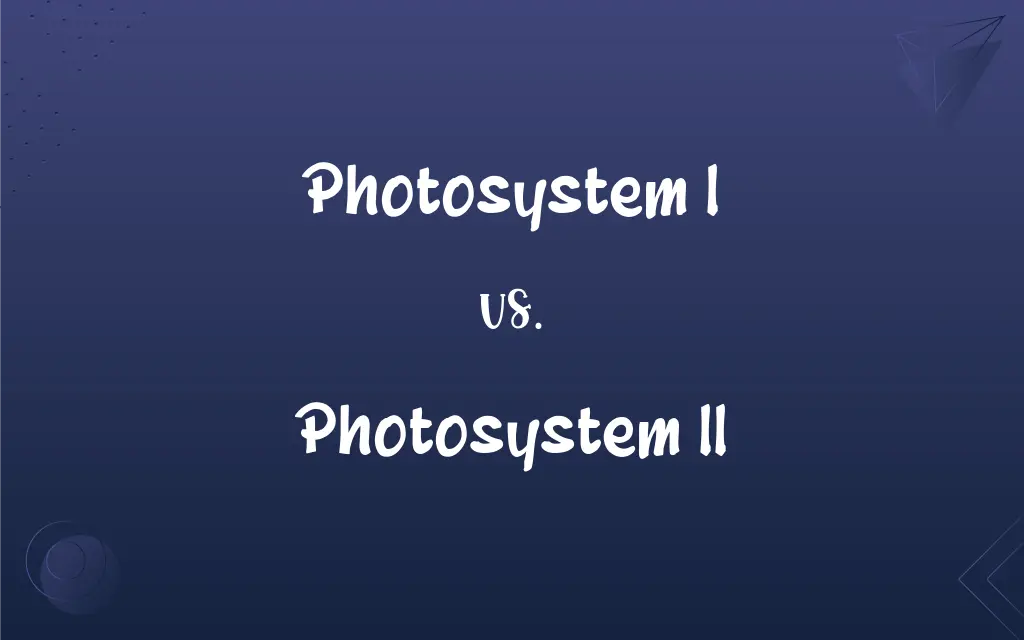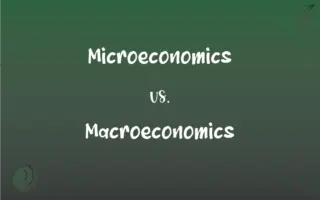Photosystem I vs. Photosystem II: What's the Difference?
Edited by Aimie Carlson || By Harlon Moss || Updated on October 12, 2023
Photosystem I (PSI) and Photosystem II (PSII) are complexes in plants aiding photosynthesis; PSI replenishes lost electrons of PSII, which splits water molecules, respectively.

Key Differences
Photosystem I (PSI) and Photosystem II (PSII) are fundamental components of the photosynthetic machinery in chloroplasts. PSI predominantly aids in generating the reducing power, providing electrons to ferredoxin. Conversely, PSII initiates the electron transport chain and is vital in photolysis, liberating oxygen through the splitting of water.
Each photosystem, PSI and PSII, bears distinct absorbance peaks pertaining to the wavelengths of light they absorb most efficiently. PSI primarily absorbs light with a wavelength of approximately 700 nm, hence often denoted P700. Conversely, PSII absorbs light most efficiently at a wavelength of around 680 nm, thus referred to as P680.
PSI and PSII are characterized by their diverse roles in the Z-scheme (the linear electron flow) of photosynthesis. PSI predominantly functions in cyclic electron flow, contributing to the formation of a proton gradient which drives ATP synthesis. PSII, contrastingly, plays a pivotal role in non-cyclic electron flow, facilitating the synthesis of both ATP and NADPH.
The structural and compositional constituents of PSI and PSII underscore their functional differentiation. PSI harbors more chlorophyll-a molecules, facilitating its function in capturing light energy, which subsequently triggers the transfer of electrons from P700. PSII, however, is crucial in accommodating the initial charge separation, with its distinguished D1 and D2 protein core that aids in binding specific cofactors and pigments essential for electron transfer.
In the broader photosynthetic context, the synchronized actions of PSI and PSII are paramount in ensuring the efficiency and continuity of the light-dependent reactions. PSI, through its light-harvesting activities, generates energy that indirectly supports the Calvin cycle, sustaining the plant’s ability to synthesize sugars. Meanwhile, PSII substantiates the electron deficiency in PSI by generating electron flow through the splitting of water, thereby maintaining the overall balance and productivity of the photosynthetic process.
ADVERTISEMENT
Comparison Chart
Primary Function
Generates reducing power
Splits water molecules, liberating oxygen
Absorbance Peak
Approx. 700 nm (P700)
Approx. 680 nm (P680)
Role in Electron Flow
Facilitates cyclic electron flow
Involved in non-cyclic electron flow
Structural Component
Rich in chlorophyll-a molecules
Houses D1 and D2 core proteins
Contribution to Photosynthesis
Aids ATP formation via proton gradient
Enables both ATP and NADPH synthesis
ADVERTISEMENT
Photosystem I and Photosystem II Definitions
Photosystem I
Photosystem I (PSI) is a protein complex that facilitates light absorption in photosynthesis, driving cyclic electron flow.
In plants, Photosystem I plays a pivotal role in generating the proton motive force for ATP synthesis.
Photosystem II
Photosystem II operates prominently in non-cyclic electron transport, producing both ATP and NADPH used in the light-independent reactions.
By engaging in non-cyclic electron flow, Photosystem II ensures the generation of essential energy carriers for subsequent photosynthetic stages.
Photosystem I
PSI, known as P700, optimally absorbs light at a wavelength of approximately 700 nm.
Photosystem I primarily engages with light energy close to the 700 nm spectrum to initiate its electron transfer cascade.
Photosystem II
Photosystem II (PSII) is a protein complex vital for initiating the light-dependent reactions of photosynthesis by splitting water.
Photosystem II liberates oxygen into the atmosphere through the process of photolysis, significantly influencing global oxygen levels.
Photosystem I
PSI utilizes its rich chlorophyll-a content to efficiently capture light and excite electrons.
Through the abundant chlorophyll-a molecules, Photosystem I ensures effective light absorption to propel electron flow.
Photosystem II
PSII, characterized by its core D1 and D2 proteins, facilitates electron movement from water to plastoquinone, ensuring electron availability in photosynthesis.
The unique structure of Photosystem II, including the D1 and D2 proteins, enables the crucial electron transfer that underpins photosynthetic electron flow.
Photosystem I
Photosystem I contributes to the generation of reducing power in the chloroplast by reducing ferredoxin.
The light-induced electron transfer within Photosystem I culminates in the reduction of ferredoxin, aiding subsequent biosynthetic processes.
Photosystem II
PSII, also referred to as P680, absorbs light most efficiently at a wavelength of 680 nm, driving the primary charge separation in photosynthesis.
The P680 chlorophyll pair in Photosystem II effectively harnesses light of approximately 680 nm, propelling electrons into the electron transport chain.
Photosystem I
PSI participates prominently in cyclic electron transport, which forms a proton gradient for ATP synthesis without producing NADPH.
Photosystem I facilitates the cyclic flow of electrons, bolstering the creation of a proton gradient instrumental in ATP formation.
Photosystem II
Photosystem II plays an indispensable role in establishing the proton gradient across the thylakoid membrane by channeling protons into the thylakoid lumen.
By channeling protons during water splitting, Photosystem II contributes to the electrochemical gradient essential for ATP synthesis within chloroplasts.
FAQs
Why is Photosystem I also referred to as P700?
PSI is dubbed P700 due to its optimal light absorption at a wavelength of approximately 700 nm.
What wavelength of light does Photosystem II absorb best?
PSII best absorbs light at a wavelength of around 680 nm, hence often termed P680.
How does Photosystem I contribute to ATP synthesis?
PSI aids ATP synthesis through cyclic electron flow, which establishes a proton gradient across the thylakoid membrane.
Is Photosystem II found in non-photosynthetic organisms?
No, PSII is specific to photosynthetic organisms like plants, algae, and cyanobacteria.
Which photosystem evolved first, PSI or PSII?
PSII is believed to have evolved first, followed by the evolution of PSI.
Does Photosystem I directly contribute to the creation of a proton gradient?
Yes, through cyclic electron flow, PSI indirectly facilitates the formation of a proton gradient necessary for ATP synthesis.
Is Photosystem I involved in the liberation of oxygen during photosynthesis?
No, PSI is not involved in liberating oxygen; this is a function of PSII through the process of photolysis.
What is the primary function of Photosystem I (PSI)?
PSI primarily functions to generate reducing power, providing electrons to ferredoxin.
What are the key structural components of Photosystem II?
PSII is characterized by its D1 and D2 core proteins and several cofactors and pigments essential for electron transfer.
Which photosystem is involved in non-cyclic electron transport?
PSII is crucially involved in non-cyclic electron transport, contributing to both ATP and NADPH formation.
How does Photosystem II contribute to the proton motive force?
PSII channels protons into the thylakoid lumen during water splitting, contributing to the proton motive force.
Why is the reducing power generated by Photosystem I important?
The reducing power from PSI (electrons transferred to ferredoxin) is vital for various biosynthetic reactions, including the reduction of NADP+ to NADPH.
Can Photosystem II function without Photosystem I in photosynthesis?
No, PSII and PSI work cooperatively; the electrons from PSII replenish those lost by PSI, maintaining the continuity of the electron transport chain.
Where are PSI and PSII located in plant cells?
Both PSI and PSII are located in the thylakoid membranes of chloroplasts.
How does Photosystem II (PSII) contribute to oxygen levels in the atmosphere?
PSII releases oxygen into the atmosphere by splitting water molecules during photolysis.
About Author
Written by
Harlon MossHarlon is a seasoned quality moderator and accomplished content writer for Difference Wiki. An alumnus of the prestigious University of California, he earned his degree in Computer Science. Leveraging his academic background, Harlon brings a meticulous and informed perspective to his work, ensuring content accuracy and excellence.
Edited by
Aimie CarlsonAimie Carlson, holding a master's degree in English literature, is a fervent English language enthusiast. She lends her writing talents to Difference Wiki, a prominent website that specializes in comparisons, offering readers insightful analyses that both captivate and inform.































































